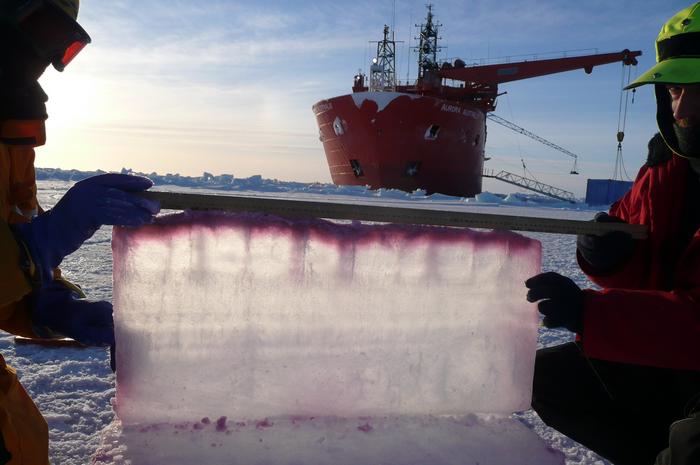A new applied mathematical theory could enhance our understanding of how sea ice affects global climate, potentially improving the accuracy of climate predictions.

Credit: Professor Ken Golden
A new applied mathematical theory could enhance our understanding of how sea ice affects global climate, potentially improving the accuracy of climate predictions.
The authors of a new paper published in the Proceedings of the Royal Society A on 28 August, offer new insights into how heat travels through sea ice, a crucial factor in regulating Earth’s polar climate.
Dr Noa Kraitzman, Senior Lecturer in Applied Mathematics at Macquarie University and lead author of the study, says the research addresses a key gap in current climate modelling.
“Sea ice covers about 15 per cent of the ocean’s surface during the coldest season when it’s at its vast majority,” Dr Kraitzman says. “It’s a thin layer that separates the atmosphere and the ocean and is responsible for heat transfer between the two.”
Sea ice acts as an insulating blanket on the ocean, reflecting sunlight and moderating heat exchange. As global temperatures rise, understanding how sea ice behaves will become increasingly important for predicting climate change.
The study focuses on the thermal conductivity of sea ice, a critical parameter used in many global climate models. The movement of liquid brine within sea ice, which can potentially increase its heat transport, was not accounted for in previous models.
Dr Kraitzman says the unique structure of sea ice, along with its sensitive dependence on temperature and salinity, means it is challenging to measure and predict its properties, specifically its thermal conductivity.
“When you look at sea ice on a small scale, what makes it interesting is its complex structure because it’s made up of ice, air bubbles, and brine inclusions.
“As the atmosphere above the ocean becomes extremely cold, below minus 30 degrees Celsius, while the ocean water remains at about minus two degrees, this creates a large temperature difference, and the water freezes from the top down.
“As the water freezes rapidly, it pushes out the salt, creating an ice matrix of purely frozen water which captures air bubbles and pockets of very salty water, called brine inclusions, surrounded by nearly pure ice.”
These dense brine inclusions are heavier than the fresh ocean water which results in convective flow within the ice, creating big ‘chimneys’ where liquid salt flows out.
The research builds on earlier field work by Trodahl in 1999, which first suggested that fluid flow within sea ice might enhance its thermal conductivity. Dr Kraitzman’s team has now provided mathematical proof of this phenomenon.
“Our mathematics definitely shows that such an enhancement should be expected once convective flow within the sea ice begins,” Dr Kraitzman says.
The model also offers a way to relate the sea ice’s thermal properties to its temperature and salt content, allowing theoretical results to be compared with measurements.
Specifically, it provides a tool to be used in large-scale climate models, potentially leading to more accurate predictions of future conditions in the polar regions.
Sea ice in the Arctic has been declining rapidly in recent decades. This loss of ice can lead to a feedback loop: as more dark ocean water is exposed, it absorbs more sunlight, leading to further warming and ice loss.
The loss of sea ice can affect weather patterns, ocean circulation, and marine ecosystems far beyond the polar regions.
Dr Kraitzman says understanding the thermal conductivity of sea ice is important for predicting its future.
The researchers note that while their model provides a theoretical framework, more experimental work is needed to integrate these findings into large-scale climate models.
The study was conducted by mathematicians from Macquarie University in Australia, the University of Utah and Dartmouth College, New Hampshire in the USA.
It was supported by funding from the US National Science Foundation.
Method of Research
Computational simulation/modeling
Subject of Research
Not applicable
Article Title
Homogenisation for convection-enhanced thermal transport in sea ice
Article Publication Date
28-Aug-2024
COI Statement
The authors declare no conflicts



